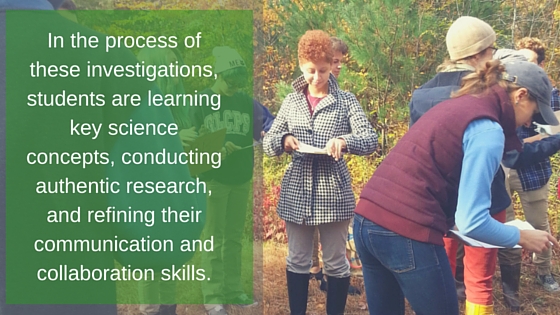Place-Based Learning in Middle School: Putting Scientific Principles to Work in your Community
By Guest Blogger
Posted on 2016-07-20
“When we try to pick out anything by itself, we find it hitched to everything else in the Universe.” -John Muir, My First Summer in the Sierra, 1911.
We hope that you are enjoying your summer! As teachers, we realize that your mind is never far from your classroom, even if your body is lounging on a chair next to *insert appropriate body of water here*. As science teachers, especially, even the sounds of waves and splashing children have entirely different meaning to us than to those in other walks of life. You might hear water hitting the beach and start pondering frequency, wavelength, and longshore drift and before you know it your mind starts generating lesson plans. Teachers are constantly mining personal experiences for ideas to help students connect what they learn to the world around them.
Making these connections is infinitely easier for our students if we are able to take them beyond the confines of the schoolroom. While the majority of us would hesitate to invite our students on summer vacation with us, we work hard to provide real-world, authentic learning opportunities for them. When students embark on a nature walk around the school grounds, enjoy a guest speaker from the local community, experience a well-planned outdoor education trip, or gather data for citizen-scientist programs science concepts come alive in a way that even the best textbooks can never match.
Many teachers are taking this experiential learning a step further and challenging their students to advance beyond experience into action through Place-Based Learning (PBL) opportunities. The intent of PBL is to bring students’ attention to a community problem, develop partnerships within the community and beyond, and connect students to their environment on an emotional as well as intellectual level. In the process of these investigations, students are learning key science concepts, conducting authentic research, and refining their communication and collaboration skills.
Middle school students at the Global Learning Charter Public School in New Bedford, MA researched animals in the local zoo during a unit on ecology and environmental standards. They shared their reports with the Buttonwood Zoo and that material was later used by the zoo to create conservation signage for zoo patrons. These same students, now in high school, became concerned about plastic pollution in local waterways and did a number of presentations on the ‘Perils of Plastics” to the school and also the New Bedford community on Save the Planet day at the Buttonwood Zoo. The students have also formed a partnership with the Buzzards Bay Coalition (BBC) to create games and pamphlets to educate the community about the life cycles and local habitats for American Eels. They continue to help monitor the health of the Acushnet River and present student-designed lessons on water quality and the American Eel at BBC local events and at the zoo.
As shown in the above examples, PBL can have long-term and far-reaching benefits for students, schools, and communities. However, many teachers are hesitant to embark on these projects due to time constraints, pressures from standardized test curriculums, and lack of funding for buses and program fees. They are not given mentors who have used PBL and can often be left to design and struggle with the planning on their own. If teachers are to embrace PBL they need help in doing so.
If you are interested in incorporating place-based learning into your lessons, we suggest that you start small, work with school families and administration, and gradually work to develop ties and partnerships with community members. Successful relationships with the community are the foundation of successful PBL. Encouraging students to enter into local and national contests accesses their natural competitive spirit and helps them to develop partnerships with organizations to obtain the resources to address the problems they have identified. For example, to further the American Eels project described above, students successfully applied to Dr. Jane Goodall’s Roots and Shoots program and the school now has two Roots and Shoots clubs on campus.
Steps to Incorporating Place-Based Learning
1) Select a local environmental issue that is interesting and relevant to you, your students, and the community.
2) Plan an inquiry project for your students that connects the work of the community organization with your standards and their local realities.
3) Identify parents, local or national organizations that address the issue and connect with them in person and online. Ask them to speak with your students and provide learning opportunities for them.
4) Include an action component in the project plan, i.e. personal change, public awareness campaign, art installation, etc. Some organizations have campaigns or projects already established and will welcome your assistance.
If you have experience with place-based learning, please share your stories and advice for other teachers in the comments below.
Diana Cost and Elizabeth Orlandi are members of NSTA’s Middle Level Science Teaching Committee. We would like to give credit to and thank Dr. Jesse Bazzul, PhD, for developing the STEPs to Place-Based Learning. His guidance was invaluable to us in crafting this program.
Join NSTA today and receive Science Scope, the peer-reviewed journal just for middle school teachers; connect on the middle level science teaching list (members can sign up on the list server); or consider joining your peers for Meet Me in the Middle Day (MMITM) at the National Conference on Science Education in Los Angeles in the spring of 2017.
The mission of NSTA is to promote excellence and innovation in science teaching and learning for all.
Future NSTA Conferences
NGSS Workshops
2016 STEM Forum & Expo, hosted by NSTA
2016 Area Conferences
2017 National Conference
Follow NSTA
Disclaimer: The views expressed in this blog post are those of the author(s) and do not necessarily reflect the official position of the National Science Teaching Association (NSTA).



